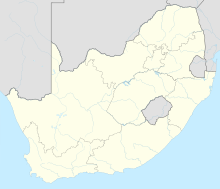Battle of Talana Hill
| Battle of Talana Hill | |||||||
|---|---|---|---|---|---|---|---|
| Part of Second Boer War | |||||||
 |
|||||||
|
|||||||
| Belligerents | |||||||
|
|
|
||||||
| Commanders and leaders | |||||||
| Lieutenant-General Sir William Penn Symons KCB † | General Lukas Meyer General Maroela Erasmus |
||||||
| Strength | |||||||
| 4000 | 3000 | ||||||
| Casualties and losses | |||||||
|
41 KIA, 185 Wounded 220 Captured or Missing |
23 KIA, 66 Wounded 20 Missing |
||||||
|
|
|||||||
|
|
41 KIA, 185 Wounded
23 KIA, 66 Wounded
The Battle of Talana Hill, also known as the Battle of Glencoe, was the first major clash of the Second Boer War. A frontal attack by British infantry supported by artillery drove Boers from a hilltop position, but the British suffered heavy casualties in the process, including their commanding general Sir William Penn Symons.
Reinforcements sent to Natal by Britain immediately before the outbreak of war had moved into the northern path of the province of Natal, but not far enough forward to occupy the passes of the Drakensberg Mountains. As a result, the Boers could invade Natal from three sides.
Lieutenant-General Sir George White in command of forces in Natal requested that forces at Glencoe (Dundee) be withdrawn to concentrate his forces at Ladysmith where he held the bulk of the British garrison. The Governor of Natal considered it necessary to hold the position for political and economic reasons, so he dispatched Lieutenant-General Sir William Penn Symons to take control of the troops at Glencoe. War was declared at 5pm on 11 October with the Boers invading on the 12 October.
Penn-Symons commanded a brigade (four infantry battalions, part of a cavalry regiment and three companies of mounted infantry, three field artillery batteries) which occupied the coal mining town of Dundee. Coal was strategically important to the British war effort as it was needed to power the British train locomotives. On the evening of 19 October, two Boer forces from the independent South African Republic, each numbering 4,000 men under General Lukas Meyer and General "Maroela" Erasmus closed in on Dundee.
Before dawn on 20 October, Erasmus' force occupied Impati Mountain north of Dundee. Meyer's men occupied the low Talana Hill east of the town at 28°9′50″S 30°16′4″E / 28.16389°S 30.26778°E, and dragged several German manufactured Krupp field guns to the top. As dawn broke and the British spotted the Boers on Talana Hill, these guns opened fire, ineffectually.
...
Wikipedia

